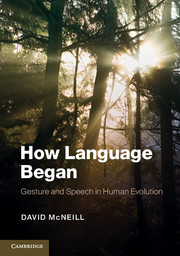Book contents
- Frontmatter
- Contents
- List of figures
- List of tables
- Preface – Out on a limb
- Acknowledgments
- 1 INTRODUCTION – GESTURE AND THE ORIGIN OF LANGUAGE
- 2 What evolved (in part) – the growth point
- 3 How it evolved (in part) – Mead's Loop
- 4 Effects of Mead's Loop
- 5 Ontogenesis in evolution – evolution in ontogenesis
- 6 Alternatives, their limits, and the science base of the growth point
- Notes
- References
- Index
5 - Ontogenesis in evolution – evolution in ontogenesis
Published online by Cambridge University Press: 05 October 2012
- Frontmatter
- Contents
- List of figures
- List of tables
- Preface – Out on a limb
- Acknowledgments
- 1 INTRODUCTION – GESTURE AND THE ORIGIN OF LANGUAGE
- 2 What evolved (in part) – the growth point
- 3 How it evolved (in part) – Mead's Loop
- 4 Effects of Mead's Loop
- 5 Ontogenesis in evolution – evolution in ontogenesis
- 6 Alternatives, their limits, and the science base of the growth point
- Notes
- References
- Index
Summary
In the language of children we hear echoes of our ancient past. And what we hear is surprising. Signals exist, especially in the early stages, of gesture-first, its supplantation by speech, its extinction, and finally the emergence of GPs, all in sequence – our ancestors turning at the branch points of Figure 3.13, the timeline of hypothetical gesture-first, its extinction, and the dawn of Mead's Loop.
PHYLOGENETIC ECHOES
Gesture-first may have existed in the two now extinct human lines, Neanderthals and Denisova hominin. It could have existed in our line and extinguished as well, but we have survived to evolve a new form of language, Mead's Loop based on speech–gesture equiprimordiality. This new language, as we have seen, could not have emerged from gesture-first and was a second origin. The current chapter draws upon the child language literature and in passing makes points about acquisition (in particular, that it is discontinuous because of the two origin echoes), but it is not an overview of children's language. The purpose is not to uncover the intricacies of language development but to scour the literature for hints, clues, signals, anything at all that suggests something of the origin (or origins) of language. This style of argument has often been doubted but there has been a recent revival of interest in it. MacNeilage (2008) has used an ontogenesis-recapitulates-phylogenesis argument to study aspects of speech origin. Such arguments can be useful and heuristic for sorting out steps in phylogenesis.
- Type
- Chapter
- Information
- How Language BeganGesture and Speech in Human Evolution, pp. 165 - 185Publisher: Cambridge University PressPrint publication year: 2012



